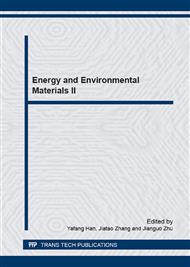[1]
J. Finley, Hot gas filtration: diesel – how prepared is the filtration industry?, Filtration & Separation. 43 (2006) 16-20.
DOI: 10.1016/s0015-1882(06)70863-1
Google Scholar
[2]
S.D. Sharma, M. Dolan, A.Y. Ilyushechkin, K.G. McLennan, T. Nguyen, D. Chase, Recent developments in dry hot syngas cleaning processes, Fuel. 89 (2010) 817-826.
DOI: 10.1016/j.fuel.2009.05.026
Google Scholar
[3]
E.H. Tanabe, P.M. Barros, K.B. Rodrigues, M.L. Aguiar, Experimental investigation of deposition and removal of particles during gas filtration with various fabric filters, Separation and Purification Technology. 80 (2011) 187-195.
DOI: 10.1016/j.seppur.2011.04.031
Google Scholar
[4]
A. Larbot, M. Bertrand, S. Marre, E. Prouzet, Performances of ceramic filters for air purification, Separation and Purification Technology. 32 (2003) 81-85.
DOI: 10.1016/s1383-5866(03)00062-5
Google Scholar
[5]
R.C. Brown, A. Thorpe, Glass-fibre filters with bimodal fibre size distributions, Powder Technology. 118 (2001) 3-9.
DOI: 10.1016/s0032-5910(01)00288-1
Google Scholar
[6]
T.J. Phelps, A.V. Palumbo, B.L. Bischoff, C.J. Miller, L.A. Fagan, M.S. McNeilly, R.R. Judkins, Micron-pore-sized metallic filter tube membranes for filtration of particulates and water purification, Journal of microbiological methods. 74 (2008).
DOI: 10.1016/j.mimet.2007.08.005
Google Scholar
[7]
W. Tanthapanichakoon, M. Hata, K. -h. Nitta, M. Furuuchi, Y. Otani, Mechanical degradation of filter polymer materials: Polyphenylene sulfide, Polymer Degradation and Stability. 91 (2006) 2614-2621.
DOI: 10.1016/j.polymdegradstab.2006.05.005
Google Scholar
[8]
B.H. Park, M. -H. Lee, S.B. Kim, Y.M. Jo, Evaluation of the surface properties of PTFE foam coating filter media using XPS and contact angle measurements, Applied Surface Science. 257 (2011) 3709-3716.
DOI: 10.1016/j.apsusc.2010.11.116
Google Scholar
[9]
M. Lupión, F.J. Gutiérrez Ortiz, B. Navarrete, V.J. Cortés, Assessment performance of high-temperature filtering elements, Fuel. 89 (2010) 848-854.
DOI: 10.1016/j.fuel.2009.04.016
Google Scholar
[10]
S. Fotovati, H. Vahedi Tafreshi, A. Ashari, S.A. Hosseini, B. Pourdeyhimi, Analytical expressions for predicting capture efficiency of bimodal fibrous filters, Journal of Aerosol Science. 41 (2010) 295-305.
DOI: 10.1016/j.jaerosci.2010.01.002
Google Scholar
[11]
A. Podgórski, A. Bałazy, L. Gradoń, Application of nanofibers to improve the filtration efficiency of the most penetrating aerosol particles in fibrous filters, Chemical Engineering Science. 61 (2006) 6804-6815.
DOI: 10.1016/j.ces.2006.07.022
Google Scholar
[12]
S.A. Hosseini, H.V. Tafreshi, 3-D simulation of particle filtration in electrospun nanofibrous filters, Powder Technology. 201 (2010) 153-160.
DOI: 10.1016/j.powtec.2010.03.020
Google Scholar
[13]
J. Wang, S.C. Kim, D.Y.H. Pui, Figure of Merit of Composite Filters with Micrometer and Nanometer Fibers, Aerosol Science and Technology. 42 (2008) 722-728.
DOI: 10.1080/02786820802249133
Google Scholar
[14]
S. Lingaiah, K. Shivakumar, Electrospun high temperature polyimide nanopaper, European Polymer Journal. 49 (2013) 2101-2108.
DOI: 10.1016/j.eurpolymj.2013.04.030
Google Scholar
[15]
D. Chen, R. Wang, W.W. Tjiu, T. Liu, High performance polyimide composite films prepared by homogeneity reinforcement of electrospun nanofibers, Composites Science and Technology. 71 (2011) 1556-1562.
DOI: 10.1016/j.compscitech.2011.06.013
Google Scholar
[16]
S. Jiang, G. Duan, J. Schöbel, S. Agarwal, A. Greiner, Short electrospun polymeric nanofibers reinforced polyimide nanocomposites, Composites Science and Technology. 88 (2013) 57-61.
DOI: 10.1016/j.compscitech.2013.08.031
Google Scholar
[17]
C. Qin, J. Wang, S. Cheng, X. Wang, L. Dai, G. Chen, Fluorescent performance of electrospun polyimide web mixed with hemicyanine dye, Materials Letters. 63 (2009) 1239-1241.
DOI: 10.1016/j.matlet.2009.02.038
Google Scholar
[18]
S.S. Homaeigohar, K. Buhr, K. Ebert, Polyethersulfone electrospun nanofibrous composite membrane for liquid filtration, Journal of Membrane Science. 365 (2010) 68-77.
DOI: 10.1016/j.memsci.2010.08.041
Google Scholar
[19]
S. -Y. Tsou, H. -S. Lin, P. -J. Cheng, C. -L. Huang, J. -Y. Wu, C. Wang, Rheological aspect on electrospinning of polyamide 6 solutions, European Polymer Journal. 49 (2013) 3619-3629.
DOI: 10.1016/j.eurpolymj.2013.07.031
Google Scholar


